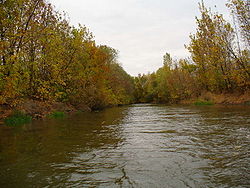| Mius | |
|---|---|
 | |
| Location | |
| Country | Ukraine, Russia |
| Physical characteristics | |
| Source | |
| • location | Donetsk Oblast, Ukraine |
| • coordinates | 48°16′44″N 38°32′16″E / 48.27889°N 38.53778°E |
| Mouth | Sea of Azov |
• location | near Taganrog |
• coordinates | 47°16′38″N 38°48′33″E / 47.2771°N 38.8093°E |
| Length | 258 km (160 mi) |
| Basin size | 6,680 km2 (2,580 sq mi) |
| Basin features | |
| Tributaries | |
| • right | Krynka |
 | |
The Mius (Ukrainian: Міус; Russian: Миус) is a river in Eastern Europe that flows through Ukraine and Russia. It is 258 kilometres (160 mi) long, and has a drainage basin of 6,680 square kilometres (2,580 sq mi).[1]
Course
[edit]The headwaters of the Mius are in the Donets Mountains, a mountain range within Donetsk Oblast. It flows through Donetsk Oblast and Luhansk Oblast in eastern Ukraine; and then through Rostov Oblast in Russia; and into the Sea of Azov of the northeastern Mediterranean Sea basin.
The river mouth of the Mius is on the Taganrog Bay coast of the Sea of Azov, west of the Russian city of Taganrog.
History
[edit]In 1941, during the World War II, the German Nazi General Paul Ludwig Ewald von Kleist created a heavily fortified defensive line known as the Mius-Front along the Mius river. It was an arena of fierce battles during the Rostov Defensive Operation in the 1941−1943 Battle of Rostov campaigns. During the 1943 Donbas Strategic Offensive Soviet troops finally broke through the Mius-Front near the village of Kuybyshevo.
Well, that’s interesting to know that Psilotum nudum are known as whisk ferns. Psilotum nudum is the commoner species of the two. While the P. flaccidum is a rare species and is found in the tropical islands. Both the species are usually epiphytic in habit and grow upon tree ferns. These species may also be terrestrial and grow in humus or in the crevices of the rocks.
View the detailed Guide of Psilotum nudum: Detailed Study Of Psilotum Nudum (Whisk Fern), Classification, Anatomy, Reproduction